What Is Muscle Atrophy?
Muscle atrophy in dogs is the wasting or loss of the dog’s muscle tissue. It often occurs in the legs, particularly the hind legs, although it can show up in other areas of the body. When atrophy results from an injury or surgery, for example during the recovery period from TPLO surgery, it may be fairly obvious. But that’s not always the case. Atrophy can occur slowly over an extended period of time without being all that noticeable, especially in dogs with longer coats.
The condition can occur for a variety of reasons. The natural aging process often results in muscle atrophy, as do illness and reduced activity. Atrophy can begin in the early stages of disease or injury. Chronic limping or surgery on a limb typically brings on atrophy, and usually much more noticeably and quickly than would otherwise be apparent.
Pain is another common cause. Dogs with joint injuries or arthritis tend to experience pain, and pain can cause a disruption in the muscle fibers. When the muscle fibers are not fully active, weakness and atrophy can result.
Disuse is another reason for atrophy. Any time your dog consistently uses a muscle less than he normally would for a prolonged period, atrophy can set in. This can be the case for dogs with arthritis, injuries, or those on extended crate rest after surgery.
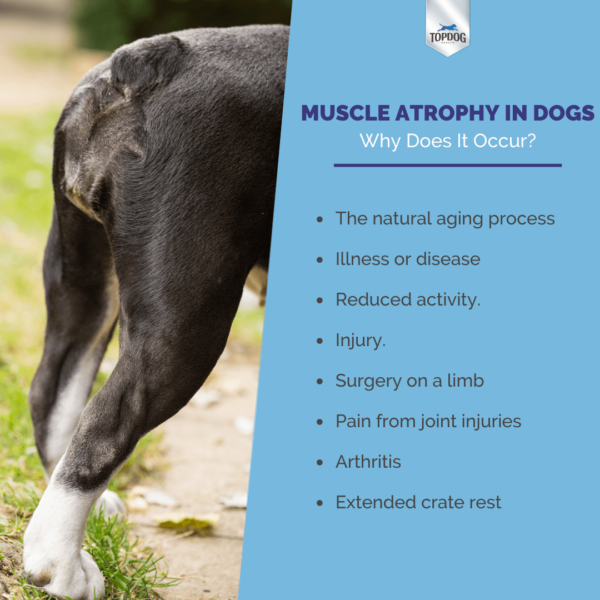
Muscle Inhibition in Dogs
Although muscle atrophy can be worrisome enough on its own, it can be compounded by another issue: muscle inhibition. Muscle inhibition refers to the shutting down of a muscle. This occurs when nerves that are normally communicating within the muscle are sending distorted messages – or no messages at all. Pain, swelling, instability, loose joints, and inflammation can all contribute to muscle inhibition.
Muscle inhibition is common after certain surgeries, such as those performed for a ruptured cruciate ligament (ACL). When your dog has ACL surgery, both atrophy and inhibition can occur.
The following pattern often emerges:
- Pain and disuse of the leg results in muscle atrophy.
- Swelling, pain, and inflammation from the injury and the surgery cause muscle inhibition
- Muscles surrounding the joint compensate for the inhibited muscles, resulting in tightening and possible overuse.
- The compensation can result in misalignment and limitations within the joint.
- The weaker muscles become even weaker since they are not being used.
- Strong muscles become even stronger since they are taking on the extra load.
Because they’re not receiving proper neurological messages, inhibited muscles cannot be strengthened unless they’re first re-activated.
How to Spot Muscle Atrophy in Dogs
Regularly checking your dog’s muscles can be a helpful habit for spotting atrophy in the early stages. In addition to muscles that appear to be shrinking or thinning, other signs of atrophy can include:
- Weight loss
- Soft, weak, flabby muscles
- Limping or paw dragging
- Unbalanced gait or loss of coordination
- Progressive weakness in the rear limbs
- Rear limbs that can no longer support body weight
- Difficulty holding up the body
- Sagging back or other changes in posture
- Increased lethargy or inactivity
- Crossing the legs when walking or standing
Also, keep an eye out for a change in your dog’s activities. If he starts to have problems walking up the stairs or performing other tasks that previously caused no issues, you may be witnessing the onset of atrophy.
How to Fix It
When muscle atrophy in dogs is caused by inactivity, it is often possible to reverse the muscle loss with exercise and adequate nutrition. As dogs get older, their nutritional needs may change. They may also become sensitive to certain nutrients. A consultation with your vet is a wise idea before making any changes to your dog’s diet. Your vet and other animal professionals may also recommend specific nutrients that can help. Adding a comprehensive supplement like GlycanAid HA can help support your dog’s joints and help your dog stay active longer reducing the likelihood of muscle atrophy.
If you’re not sure why your dog is experiencing muscle atrophy, a trip to the vet may be to determine the root cause.
How to Rebuild Muscles after Surgery
Although your dog will need some amount of crate rest after surgery, movement is an integral part of the recovery process. Crate rest without any type of activity makes it more likely for atrophy to occur. It can also lengthen the entire recovery process.
Even while confined to crate rest, you can engage your dog in stimulating activities to keep his mind and body active. Make sure the activities are adapted to align with your dog’s specific injury and activity capabilities during the recovery process. Start off slow and easy, gradually increasing the amount and type of activities as your dog becomes stronger. Check out our home rehabilitation guides for in-depth information regarding activities after surgery.
Importance of Dog Physical Therapy
Dog physical therapy can likewise help in the recovery and healing process. Canine physical therapy uses the same type of modalities and techniques used for humans, with the overall goal of reducing pain while increasing function and mobility. There are two main types of dog physical therapy: manual therapy and therapeutic exercises. The most comprehensive recovery program typically includes a combination of both.
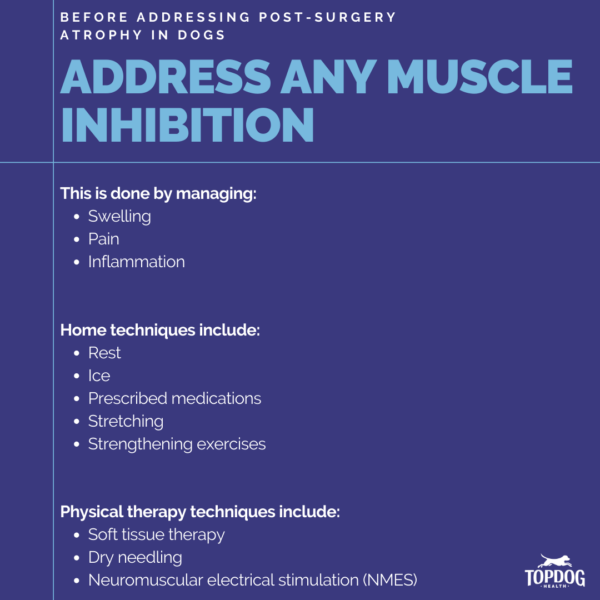
Before addressing post-surgery atrophy in dogs, it’s important to address any muscle inhibition. This is done by managing the swelling, pain, and inflammation that contribute to the inhibition. Home techniques can include rest, ice, and prescribed medications.
Muscle inhibition can be further addressed by targeting the affected muscles using physical therapy techniques such as soft tissue therapy, dry needling, and neuromuscular electrical stimulation (NMES). Best done by a professional, NMES uses low-level electrical currents to enhance healing. Such techniques can help re-activate the inhibited muscle.
Manual therapies, such as stretching and strengthening exercises, can help reduce tightness in other muscles around the joint.
Once muscle inhibition is addressed, strengthening exercises can be fully effective. The key is to overload the affected muscles to strengthen them, but it needs to be done gently, carefully, and gradually. Dog physical therapy is an ideal way to first help with the recovery process and then to continue to strengthen the muscles after healing.
To Sum Up:
To most effectively deal with muscle atrophy in dogs, you need to first know what’s causing it. You can then move forward with an appropriate treatment program from there. The program needs to address the underlying cause while ensuring your dog is receiving adequate nutrition based on his specific needs. We have a selection of quality nutritional supplements available at TopDog Health & Rehabilitation to help with atrophy and other pertinent issues that affect your dog’s quality of life, in addition to rehabilitation guides that walk you through how to do physical therapy at home.
Recommended Products:
You Might Also Be Interested In:
- Is Cold Laser Therapy Right for Your Dog?
- Acupuncture for Dogs: What You Need to Know
- Joint Care After Your Dog’s Surgery: What to Do 1 Year, 2 Years, and 5 Years Out
- The Benefits of Canine Massage: How and Why to Massage Your Dog
- What Are The Different Types of Dog Physical Therapy?
- How an ACL Tear in Dogs Can Cause Other Injuries


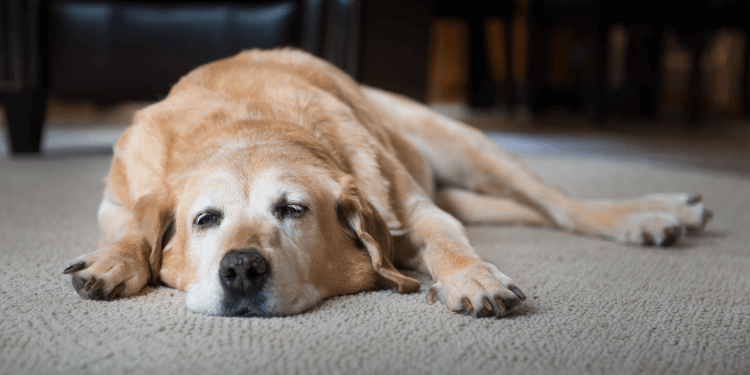
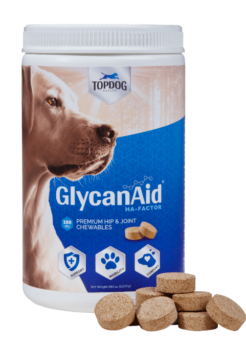
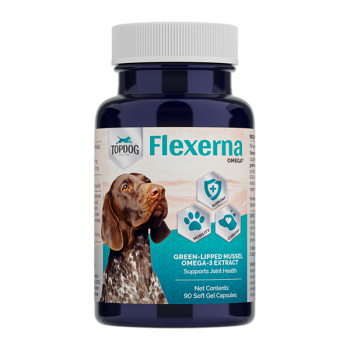 Flexerna Omega
Flexerna Omega 







